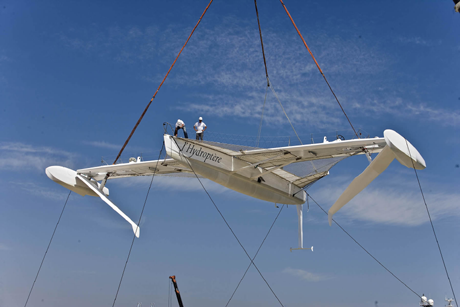
Sailing is a sport in which races are routinely won at speeds of less than 6 knots. That's 11 kilometres per hour. In such a realm, the notion of sailing a small boat faster than one drives down the highway is, in a word, unimaginable.
But this summer, using nothing but wind power, someone is likely to drive a sailboat faster than 50 knots. (That's 92.6 kilometres per hour.) In so doing, some fortunate skipper will become the first to break a record that for generations has been to sailors what the four-minute-mile was to runners, or the sound barrier was to aviators.
The contenders include windsurfers, kite-boarders and an exotic "flying yacht" called l'Hydroptère. Using lightweight construction materials and GPS speedometers, they are not only closing in on the elusive record, but also opening up what promises to be the most innovative era for sea travel in a hundred years.
French windsurfer tops 49 knots
French windsurfer Antoine Albeau holds the current absolute sailing speed record. On March 5th of this year, he skimmed along a shallow canal at Saintes Marie de la Mer at 49.09 knots (90.9 km/h).
Due to their light weight, windsurfers plane more readily than any other common type of sailboat. So while other sailors expend most of their wind power pushing water aside, windsurfers are able to translate most of that energy into speed.
Albeau, who also holds eleven windsurfing championship titles, set the speed record on an uncommonly flat body of water. The Canal des Saintes Marie de la Mer features a 500-meter course that was built for this purpose. (The previous record of 48.7 knots was set on the same canal by Finian Maynard in 2005.)
A measured course is one of the verification requirements set by the World Sailing Speed Record Council (WSSRC), which was founded in 1972 to confirm speed records of sailing crafts on water.
German kite boarder claims 50 knots
German kite boarder Tilmann Heinig claims to have broken the 50-knot barrier five weeks earlier on an unmeasured course. Heinig's personal GPS data indicates he maintained an average speed of 50.9 knots over a distance of 500 metres in Westerhever, Germany, on January 26.
A kite-boarding website and several German newspapers have recognized Heinig's claim, but the record council does not. The WSSRC will not ratify the record because of the lack of a defined course, and because the handheld GPS Heinig used does not meet its accuracy standards.
The dispute highlights a longstanding internecine dispute between windsurfers and kite boarders. Board sailors of both persuasions continue to chip away at the 50-knot barrier this summer.
Neither windsurfers nor kite boarders are able to sail this fast over the sort of waves normally associated with high winds. And neither can carry passengers or gear. For that, a hydrofoil is required.
l'Hydroptère refitted in bid for record
l'Hydroptère is a 60-foot hydrofoiling trimaran. The outer hulls --- or amas --- are fitted with hydrofoils. Upon reaching a speed of about 12 knots, the boat lifts all its hulls out of the water and planes above the waves.
The so-called "flying yacht" set a category record last year, averaging 41.69 knots over a full nautical mile.
The all-carbon trimaran was dry-docked over the winter, where skipper Alain Thébault and crew reconfigured the boat specifically to make an attempt on the 50-knot title. Design changes have included shortening the mast, and optimising the boat's hydrodynamics.
l'Hydroptère was re-launched near Marseille last week. Thébault plans to spend the next few weeks conducting speed trials on a stretch of relatively flat water nearby at Port Saint Louis du Rhône, where the mistral winds frequently blow at 30-35 knots.
Composites changing sea travel
Two other full-sized boats are also vying for the 50-knot record this year: SailRocket, a two-hulled boat, has been sailing this spring on the flat, windy waters of Walvis Bay, Namibia. And Macquarie Innovation, an Australian multi-hull, reached 44 knots last year and plans to try again.
The sudden crush of contenders for the 50-knot record is primarily the result of the radical advances in boatbuilding materials. Sailing hydrofoils date back to before the Wright Brothers, who experimented with a flying catamaran in 1907. But it was not until the advent of high-tech composite materials that combine profound lightness with extreme strength that this generation of boats could be built.
l'Hydroptère's foils, for example, are made from carbon and titanium composites; aluminium could withstand the stresses, but would render the boat too heavy.
The l'Hydroptère team is already planning a larger version capable of slashing the round-the-world record to 40 days. Like their competitors, they expect to see elements of their cutting-edge designs appearing in sport and commercial watercraft within a decade.
"One thing is certain," the l'Hydroptère website states, "2008 is the year of the absolute sailing speed record ... There are too many contenders and there is too much motivation for the record to remain at its current level. The whole community is dreaming of sailing at 50 knots."
Related Tyee stories:
- Fastest Human, Under Construction
Prosthetics may zoom amputees past 'able bodied' sprinters. - Confessions of a Naked Rower
Interview with Colin Angus, author of Beyond the Horizon: The Great Race to Finish the First Human-powered Circumnavigation of the Planet - The Lost Art of Racing (photo essay)
When the machines, and the men, still thrilled.
Read more: Transportation, Science + Tech















Tyee Commenting Guidelines
Comments that violate guidelines risk being deleted, and violations may result in a temporary or permanent user ban. Maintain the spirit of good conversation to stay in the discussion.
*Please note The Tyee is not a forum for spreading misinformation about COVID-19, denying its existence or minimizing its risk to public health.
Do:
Do not: